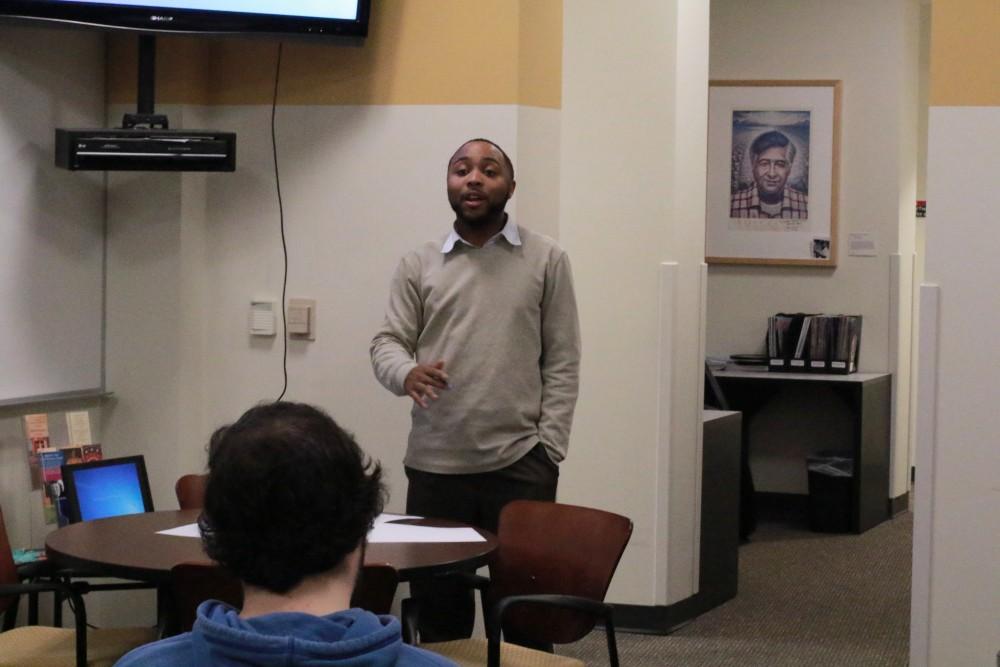Bringing context onto campus

GVL / Maddie Forshee
Dec 2, 2015
With the recent emphasis on international events in the media garnering swift and constant coverage, many students are left without context or understanding of these events and how they might affect them.
Conversations of Color, a new discussion series hosted by the Office of Multicultural Affairs, is a space for students, faculty and staff to gather to discuss topics, gain understanding and learn about current events.
ReChard Peel, a graduate assistant for the OMA, began the series because he saw a definitive lack of serious conversations on campus.
“The office has a lot of built-in celebrations, and while that’s important and beneficial and great, there’s also the need to talk about the harder issues and harder conversations,” he said.
The first Conversations of Color discussion was centered around Ahmed Mohamed, a Muslim teen that was arrested for bringing a homemade clock to school in September. Since then, the series has hosted two other discussions, ranging in topic from the anniversary of the march on Washington to the protests at the University of Missouri.
On Dec. 1, the fourth installment in the Conversation of Color series focused on the terrorist attacks in Paris and Beirut and the broader topics of Islamophobia in the media.
Since the discussion dealt with race, the Kaufman Interfaith Institute reached out to the OMA to act as a catalyst for discussion and a resource for students during and after the event.
“The increase in Islamophobia and anti-Muslim sentiment is something that we are really concerned with and we want to promote conversations that encourage us to overcome the stereotypes that mainstream media perpetuates,” said Katie Gordon, program manager for the Kaufman Interfaith Institute. “Considering a student’s identity is important to creating a campus environment that is inclusive of those backgrounds.”
About 15 students and staff gathered in the OMA for an hour of critical thinking regarding the issues at hand.
Peel explained what had happened in Paris and Beirut, talking about related attacks, similar historical events and even explaining what ISIS is and does as an organization. After opening the floor to initial reactions, attendees ignited the discussion and began to explore the idea of race and media coverage.
Throughout the conversation, many questions were asked and many topics were explored, and Peel said that is exactly the reason he enjoys facilitating the discussions.
“Students need an outlet to discuss (things like this) in a broader context with more diversity of opinion and thoughts (with) more people challenging them and supporting them,” Peel said. “I think that this provides that outlet.”
Many of the attendees talked about the idea of media coverage and fairness in the international context and in the national context.
“Bringing things to current events doesn’t happen with students in higher education,” said Peel. “These types of dialogues are beneficial. Students can get a better understanding, they can learn, there’s a lot of development that can happen.”
The conversation helped bring the events abroad to a more local context, when people talked about Muslim inclusivity on campus and people seeking refuge in Grand Rapids.
“As a consequence of the attacks and the media coverage led to a heightened fear of the ‘other,’ increasing Islamophobia and anti-refugee rhetoric,” Gordon said. “I hope that this conversation is a starting place for us as a campus to reflect on how we can continue to be welcoming to all people, despite our differences.”
Peel said he is hopeful that Conversations of Color will continue throughout the year and will draw people from across campus and engage them in meaningful conversation. Identity is important to Peel, and he said even though it is focused on race, all facets of identities are welcome in the discussions.
“Identity issues are intersectional,” he said. “It’s never been just about race. You can’t separate identities from each other.”
Conversations of Color is held once a month in the Office of Multicultural Affairs. The time and date vary, but these will always be posted on the OMA website at www.gvsu.edu/oma.





















